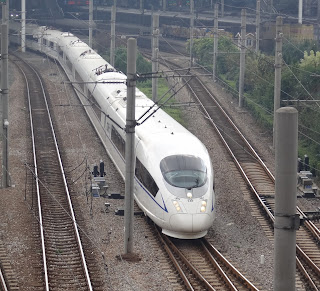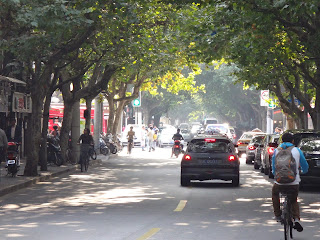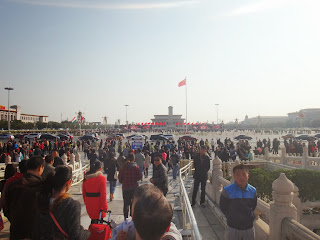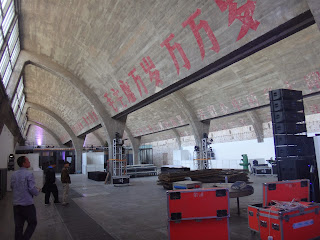Beijing Hutong
Beijing Hutong
I realize i like this town a lot.
3) Tiananmen Square
Huge. That's really all i have to say. I just look at it from the northern edge - where the entrance to the Forbidden city is.
Tiananmen Square
No tanks or men with grocery bags. Just a vast empty space, ringed with tourists. Although, two days after i stand here, and in this very spot, an attack occurs wherein 5 people are killed and forty injured as an SUV ploughs into the tourist crowd, and then detonates. Early news reports indicate it is an attack tied to Uighur separatists.
4) The Forbidden City

Outside Main Gate of Forbidden City, Beijing
Also huge. Too big to see in an afternoon. What i hadn't clocked before was that the name "city" isn't a misnomer. There are many, many buildings, and many vast open spaces. It gets its name from its 500 year long stint as the home of the emperor - where no one could enter or leave without the emperor's permission. Although, in modern Mandarin, it is officially referred to as simply the "Palace Museum".
Forbidden City, Beijing
Forbidden City, Beijing
Forbidden City, Beijing
Forbidden City, Beijing
What most appeals to me is a ceramics collection in a building i wander into - a display of China in China, from about 7000 years ago to now. Some of the most ancient of these relics look, to my eye, as modern as anything i could find in a fancy store in Paris or Berlin.
Qing Dynasty piece. Dated 1662-1722 AD
Yuan Dynasty piece. Dated 1271-1368 AD
Southern Song Dynasty piece. Dated 1127-1279 AD
Tang Dynasty piece. Dated 618-907 AD
Neolithic Era piece. Dated 5400-4000 BCE
It turns out that one of my favourite pieces - simple, elegant, beautiful - was made somewhere around 5000 BC. it's a shocking discovery. Human artistry doesn't evolve, it seems. It may shift from one era to the next, from one style, form or fashion to another, but we are no more or less creative than ever. This 7000 year old vase is beautiful to my 21st century eye.
A jarring slap in the face is the exit from the Forbidden City at its northern wall. I walk out in a revery, and am accosted by a sea of aggressive entrepreneurs trying to sell me memorabilia, watches or rickshaw rides. also ranged along this street are beggars - a collection of some of the most mutilated humans i have ever seen - with missing limbs, enormous scars, crutches, and horrifically burned faces. several are singing, karaoke style, along with boom boxes, displaying their injuries to the sea of tourists. This is a pageant of desperation under the shadow of an emperor's palace. I wonder how long something like this has been here. I hurry past, overwhelmed. These few hundred metres are unlike the Beijing in which i have been wandering for the last two days, and i am eager to return to calm anonymity of the hutongs, and dumpling shops.
4) 798 Arts
Housed in a vast factory complex designed by East German engineers in a Bauhaus style the 1950s, is a collection of galleries, cafes, and shops. For a Toronto resident, it feels exactly like the Distillery District, but about 20x the size. The whole thing is referred to as 798 Arts - after the number name of one of the old factories. At first it is hard to find an artist among all the bars, cafes and restos with their plethora of lattes and laid-backedness. I think the artistic hey day for this area may have passed a few years ago (there is, apparently, another similar district further south and less commercial - one which i am sad to have only learned about when back in toronto). Nonetheless, i find some lovely work in a few of the galleries, and am amazed at how the commercialization of Artsyness is happening here as well.

The headless party man
Red Venus - 3D digital style
A Wang Keping carving
A photo by Luo Dan - using glass plates to make photos of people living in rural China - as if time has stopped in these regions
Photo manipulation by Yu Xiao: boys, kites and buidings
Interior of a 798 Arts building
Chinese flag painted on a giant circuit board
Sculpture - horse and bunny person...
Sculpture - shark on a chair
Enormous painting by Yu Hong - Ladder in the Sky
Detail
Detail
Detail
One thing i don't see is too much overtly political art - unlike at the similar (but less commercial) complex i visited in Shanghai (M50), and unlike the work of the famous nearby resident, Ai Wei Wei (currently under house arrest). Still - its a great place to visit, and one sees why Chinese visual art is the arguably the hottest in the world: there's some great work happening.
5) Layer Code
I visit the Peoples' Liberation Army theatre (about a 1000 seat hall) to see the work of the dance company i visited on my first day in Beijing: Beijing Dance LDTX.
PLA Theatre, Beijing
It is a fascinating show. The pre-set is riveting: a large white box set with a succession of enormous tiled video images of each of the dancer's faces in extreme close up on the upstage wall - the faces shift in slo-mo, with each tile moving at a slightly different speed, as an atmospheric soundscape plays. it's enormously compelling.
Layer Code preset
The piece runs about an hour, and the first 15 minutes are amazing. the choreographer knows how to make satisfying, extremely athletic movement, and the dancers know how to dance it. The design is gorgeous - high-end light and video effects. So far so good. But then - like so many dance pieces in so many countries (that aren't Belgium!) - the piece doesn't develop beyond its athleticism. The movement offers no dynamic change - depth and complexity don't develop, and the whole doesn't ever add up to more than its constituent parts. granted - this is one of the hardest things to do, especially in an abstract form, but i can't help being saddened. I sooo want this to be mind blowing, but it is, instead, another dance piece that has a great potential it doesn't quite realize.
I think perhaps cities like Beijing, Tehran and, yes, Toronto all suffer from isolation. too many young artists in these places don't get to see enough of the best work on the planet, first-hand. China and Iran suffer from political isolation, and English Canada from a combination of geographic isolation with a self-imposed lack of interest in the the very best contemporary work (how often did Pina Bausch's company visit Toronto, for example? answer: once, when most of the young artists in the city were still toddlers). Without direct experience of each others' work, artists can't be at the top of their game. It's that simple. As China opens, and as more connections happen, i expect this to change with companies like LDTX. For English Canada, i live in hope...
6) Square Dancing, Hutong Style
My final night in Beijing is unforgettable. Beijing-resident american producer Alison Friedman and i go out looking for a drink among the hutongs. We find a tiny place called the Malty Dog, which seems to be hosting a square dance evening. Yes: square dance. Random.

The Malty Dog
A group of young Chinese patrons are dancing to the fiddle and guitar music of a couple of white guys with hipster beards. The fiddler speaks Mandarin. The guitar player calls in English. It is an unexpected event in a Beijing back alley. Moreover, the guitar player comes over to talk to us, and it turns out he's from Pickering. he teaches at a local university. THEN, as he he talks, Alison realizes that she is putting a tour together for these guys - but it's all been over email, and they haven't met face-to-face until now. We dance.
About an hour in, a Scottish friend appears with three Chinese theatre folks. The Scot is Graham McLaren, who is now an Associate Artist at the National Theatre of Scotland (he is known to Toronto for his shows with Necessary Angel: Hamlet and Andromache). Graham is in town to put together a project with China's National Theatre, and this is the only chance we've had to have a drink together. His Chinese assistant from Scotland is with him (a delight to be around), as is perhaps the only indie producer of experimental work in China, and a young director who has just finished RADA's directing program in London (another whip smart young'un). It's a fun bunch, and we talk shop, drink some amazing micro-brewery beer, and square dance. At one point, Graham turns to me and says, "It's like the gold rush! There are people from all over the world searching for the opportunities, searching for the gold, but not having any real idea where it is. Everyone's making it up as they go. The atmosphere is electric." He's right.
I can think of no better way to say goodbye to this place. It's a great trip, and, for me and my wee company, Volcano, a new connection is made to a region that is accelerating into all of our futures...
Beijing Airport
Beijing Airport
Beijing Airport


















































































